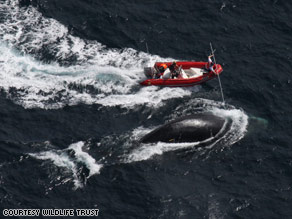Two drops of whale tranquilizer is enough to kill a person. But last week, scientists used rifle-like guns and foot-long needles to shoot two cups’ worth of the stuff into an endangered whale off the coast of Georgia. Scientists on Friday use poles and knives to try to untangle a whale off the coast of Georgia from fishing line. And, for the first time, it worked. Never before Friday had a wild whale been successfully tranquilized and freed from an entanglement that threatened its life, researchers told CNN. (See video of the dangerous encounter.) The whale — a rare, school-bus-sized whale named Bridle — was freed from hundreds of feet of fishing line that threatened the whale’s life, scientists said. That’s big news in the whale world, said Jamison Smith, large whale disentanglement coordinator for the National Oceanic and Atmospheric Administration. It means that researchers have a new tool to help whales in dangerous circumstances. Previously, when scientists tried to sedate whales, nothing noticeable happened. The scientists cautiously upped the dosage until they were successful. The fear of using too much tranquilizer on a whale is great, because it could cause a whale to stop swimming and drown, he said. Bridle is a North Atlantic right whale, which is one of the most endangered large whales on earth. Only about 400 of the school-bus-sized creatures remain, and scientists are worried by the fact that they’ve seen more of the rare whales entangled in fishing lines and gear this year than ever before. Some of the right whales are giving birth through the end of the month off the Atlantic coasts of Georgia and Florida. Record numbers of whales are being born — which is a great thing, since scientists say each one gives the species a slightly better chance for survival. But five whales have been found entangled in fishing line in the last six weeks, Smith said. He called that news “alarming,” and said it’s unclear what’s causing the increase. The lines wrap around their bodies and cause cuts and infections that often prove fatal. Bridle, the whale that was sedated, was named because it had a rope strung through its mouth, like a bridled horse, said Katie Jackson, a marine mammal biologist with the Florida Fish and Wildlife Conservation Commission. (Read more about how Jackson and others free the whales.) Friday was the fifth time scientists had tried to free Bridle. In other attempts, he didn’t respond to sedation and dove deep into the ocean and turned sharply to avoid tiny boats filled with rescuers, Jackson said. Smith said the whale’s injuries are extensive. So, despite the fact that the whale was freed from hundreds of feet of rope, his chances for survival are still uncertain. Jackson said Bridle’s recovery partly will depend on the whale’s will to survive. “He’s a little bit emaciated and has been having to deal with this entanglement for months now — at least. So he’s not doing well overall,” she said. “He still may not be able to survive this ordeal. It’s just going to depend on him really — and his ability to bounce back from it.” To learn more, check out these right-whale resources online: – Watch video of scientists trying to disentangle Bridle – See a CNN report on efforts to save these ‘ugly’ whales, which are slow swimmers and have funny warts on their heads – Listen to a scientist tell the stories of individual right whales — from Stumpy to Van Halen – And flip through a catalog of right whale sightings to learn more about their stories. Posted by: John D. Sutter -- CNN.com writer/producer Originally from http://scitech.blogs.cnn.com/2009/03/12/whale-sedated-at-sea-a-scientific-first/

Friday, March 13, 2009
Cetacean Successfully Sedated at Sea
Posted by
Top of the Curve
at
10:30 AM
Labels:
Animals,
Endangered,
Environment,
Oceans,
Scientists,
whales
blog comments powered by Disqus


